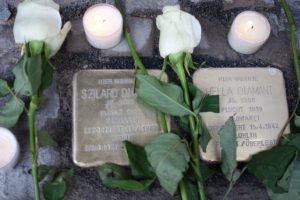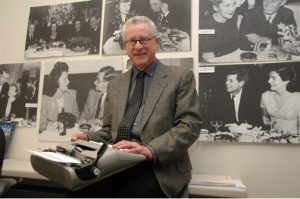Author’s Corner: Ralph Blumenthal
Author Ralph Blumenthal, whose parents were born in Berlin, worked for 45 years for The New York Times, and still contributes to the paper regularly. I am pleased to present my interview of this outstanding writer.
1) Do you remember when you first heard about the Holocaust, and what you thought about it at the time?
I was born one month before Pearl Harbor, so – a war baby. I’m sure there were whispers among the grownups about the terrible rumors from Germany and occupied Europe but I hardly remember that. My parents were working and I grew up in the care of my widowed maternal grandma Minna, who got out of Berlin in 1934 and spoke German to me, so German was practically my first language, especially since I was especially attuned to what grownups were saying in German that I wasn’t supposed to hear. At some point I think my parents realized I was growing up a little Berliner in NY (not so good in wartime America) and reclaimed me from my grandma. Once I started school and reading (in English), I had a huge interest in soldiers and WWII and emptied the public library shelves of books on the subject. So even though the Holocaust was barely being publicly comprehended in the 1950s, I knew about Nazi war crimes. I was riveted by the ghastly photos of concentration camp victims. My first big assignment after joining The New York Times out of Columbia Journalism School was as a foreign correspondent in West Germany in 1968-9 and I reported extensively on Nazi war criminals still on the loose. Back in NY in the 1970s, I received many tips from Simon Wiesenthal and broke some of the first stories on Operation Paperclip and other shameful collaboration between US intelligence agencies and ex-Nazis.
2) Recently, Ralph published in The New York Times a must-read article titled IN BERLIN, UNRAVELING A FAMILY MYSTERY, his account of laying Stolpersteine — memorial stones — for his Uncle Szilard and Aunt Hella. The article motivated me to ask Ralph: How do you feel about the Berlin of the present day?
I like Berlin, its exuberant energy, rebelliousness, contrition, weight of history, and art collections. Also the sense that my parents had walked these streets. (They emigrated to NY shortly after marrying in Berlin in 1929.) I first visited Berlin on a summer charter as a City College junior in 1961, a few weeks before the wall l went up. I reported on the divided city as a Times correspondent during the Cold War, when it was sinister indeed. And then again after reunification in 2011 when I took our two daughters (my wife not sharing my emotional attachment to Berlin) to show them the ancestral city and find the apartment house that my aunt Hella and uncle Szilard had fled under Nazi duress in 1939, laying the groundwork for my later efforts to commemorate them with Stolpersteine.

(Stolpersteine in Berlin for Ralph Blumenthal’s uncle and aunt, Szilard and Hella Diamant).
3) How would you compare and contrast the essence of New York City and the essence of Berlin?
New York has its ghosts in bygone landmarks but Berlin has far more, and far weightier ones. The Reichstag, Brandenburger Tor, Checkpoint Charlie, Topographie des Terrors, etc. New York doesn’t venerate or wallow in its history like Berlin does. There is literally a story (and often an awful one) under every Berlin cobblestone. Both world capitals share an energy and counter-culture joie de vivre, but especially Berlin. I’m thinking of you, Tacheles, now, too, just a memory. Berliners eat more outdoors (in all weather) but don’t know from putting your name down on a waiting list for a table, so there’s always an unseemly scramble when diners vacate. I love the Berlin U-Bahn where you don’t have to go through a turnstile, just buy a ticket at the machines in the station, and the trains come like clockwork.
4) Are there any interesting anecdotes about New York City’s Stork Club that didn’t make it into your book?
And speaking of ghostly New York landmarks, back in 1966, I witnessed the demise of the storied Stork Club at 3 East 53d Street, just east of Fifth Avenue, although I hardly suspected then that thirty years later I’d be writing a book about it.
I was a young Times reporter covering the parks when William S. Paley of CBS announced he was leveling the shuttered café society mecca for a vest pocket park. It made a nice spread in the paper. Utterly unconnected, in 1996 I got a call from the inimitable Jean-Claude Baker of Chez Josephine bistro on Theater Row that his adoptive mother and chanteuse namesake of the restaurant had fabricated a discrimination charge against the Stork Club in the 50s and did I know that Walter Winchell and J. Edgar Hoover had bugged the club? Well that sure got my attention, not that I ever confirmed the eavesdropping but it started me on a journey that ended with publication of Stork Club in 2000. The launch party was held at the New-York Historical Society where a section of the museum had been turned into a mock Stork Club, complete with band music, life-size cutouts of Joe Dimaggio and Marilyn Monroe, Hemingway and Frank Sinatra, and a telephone you picked up to hear Winchell broadcasting.
(Ed. — A video of the Stork Club exhibit is here. For an entertaining write-up on Ralph Blumenthal’s book about the Stork Club, go here.)
5) Which NYC establishments do you think mark the present day, as the Stork Club marked its era?
That glittering era, for better or worse, is long gone and even pale imitators like Studio 54 and the Four Seasons have fallen victim to the asocial assault of so-called social media, a synonym not for togetherness but aloneness in the company of a small glowing screen. Where do New Yorkers congregate for fun these days and nights? Don’t ask me. I’m home reading . . . books.
6) What are you working on these days?
Since retiring from The Times in 2009, after 45 years there, I’ve been a Distinguished Lecturer at Baruch College of the City University of New York where I’m working in the Library Archives on a fascinating collection about the origins of reform government in America and blogging on it. Meanwhile, and quite separately, I’m writing a biography of John E. Mack, a Harvard psychiatrist who became the foremost investigator and proponent of alien abduction. After studying hundreds of accounts of people of all ages from all walks of life from all over the world that they had encountered alien beings and been taken into spacecraft for experimentation and hybrid breeding programs, Mack grew convinced that they were not insane, liars or publicity-seekers but had experienced an actual reality unexplainable by today’s science. Mack, almost 75, was killed by a drunk driver in London in 2004. The mystery he was trying to fathom remains…a mystery. (Ed. Ralph Blumenthal’s VANITY FAIR article about John E. Mack is here).
